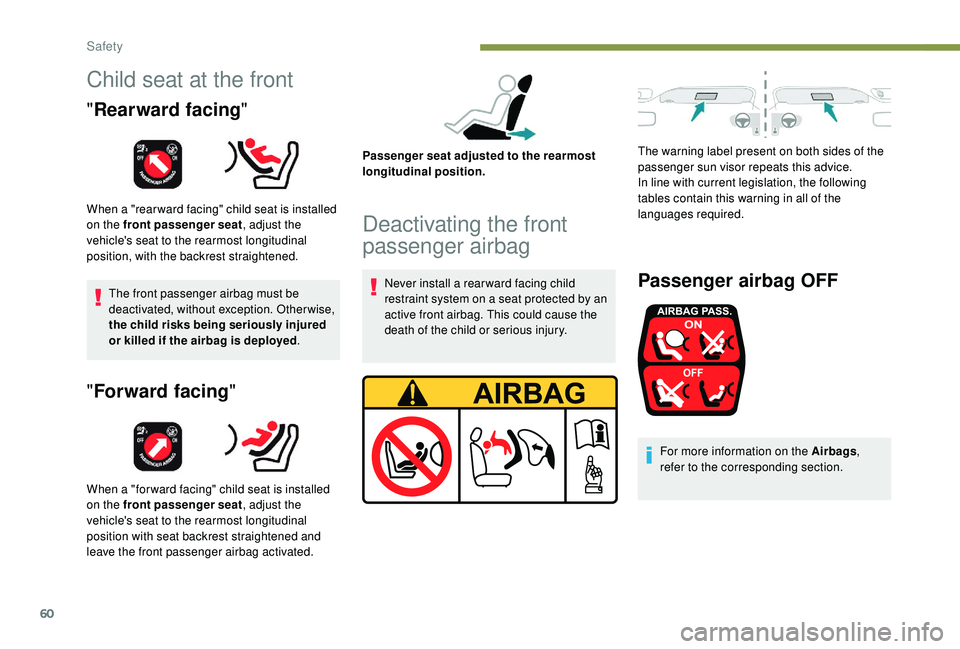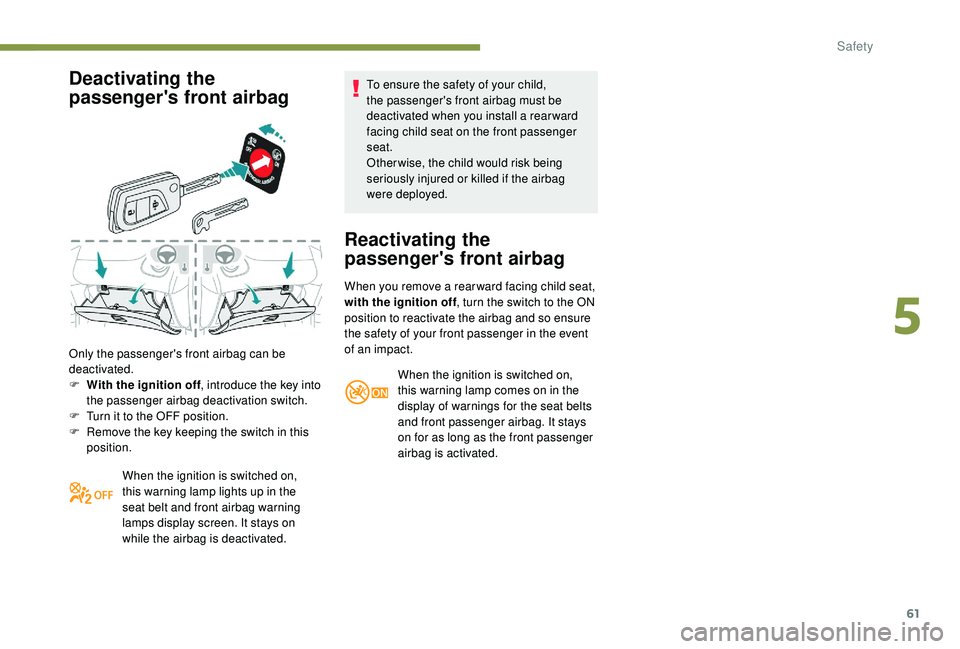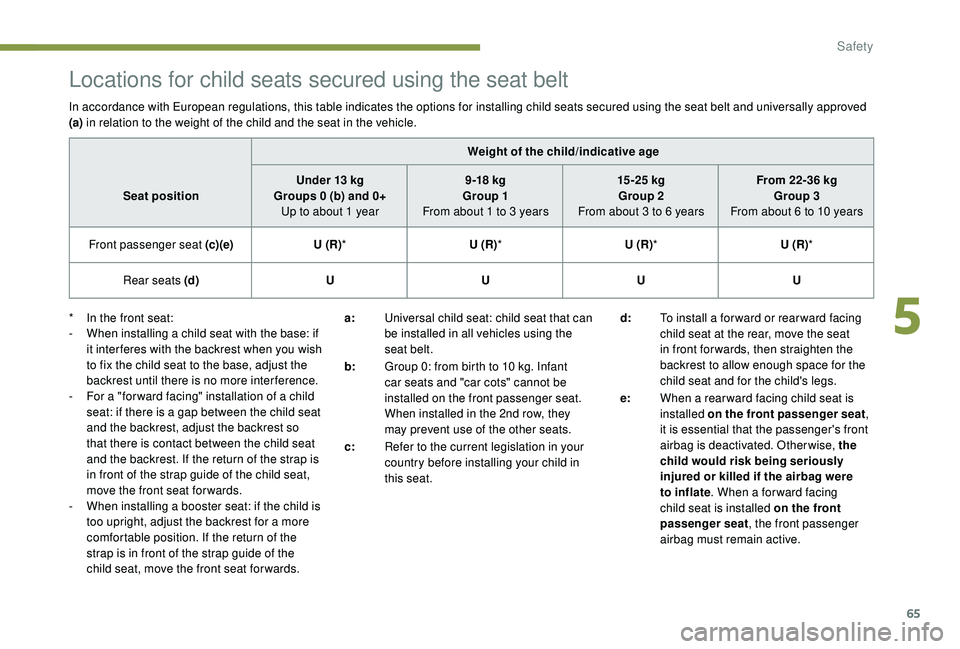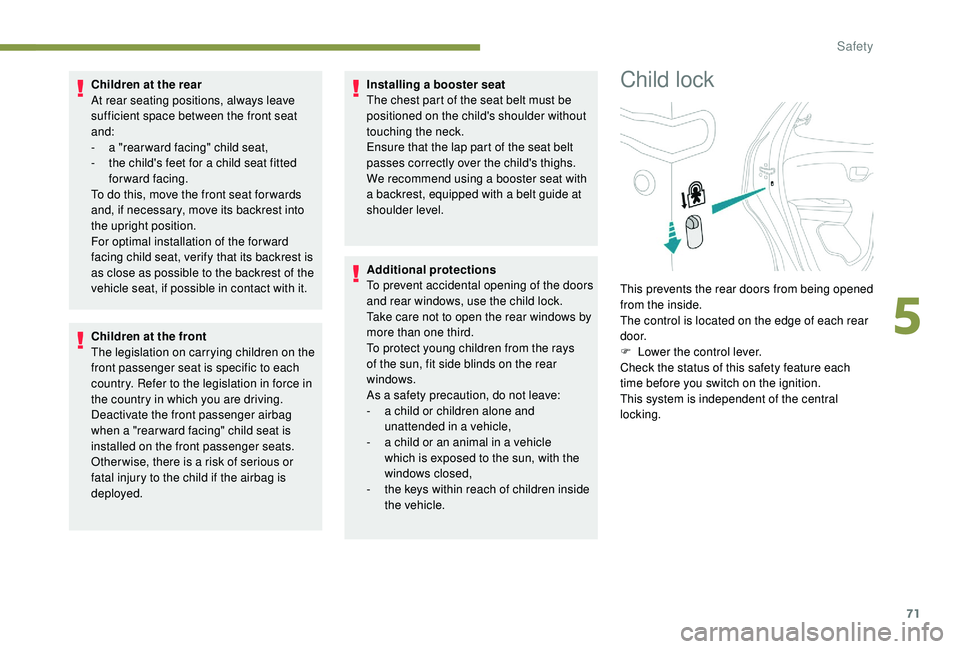2018 PEUGEOT 108 deactivate airbag
[x] Cancel search: deactivate airbagPage 11 of 180

9
Central display with an ETG
gearbox
1.Position of the gear selector and the gear
engaged.
2. Vehicle information with:
-
T
otal distance and trip recorders.
-
T
rip computer information.
-
S
peed limiter information.
-
O
utside temperature. This flashes if
there is a
risk of ice.
3. Fuel level indicator.
Warning lamps display for
the passenger seat belts and
the front passenger airbag2.Vehicle information with:
-
T otal distance and trip recorders.
-
T
rip computer information.
-
S
peed limiter information.
3. Fuel level indicator.
A.Rear left seat belt warning lamp.
B. Rear right seat belt warning lamp.
C. Front passenger airbag deactivated
warning lamp.
D. Front passenger airbag activated warning
lamp.
Warning lamp C or warning lamp D remains
lit depending on the state of the front
passenger airbag (deactivated or activated).
Warning lamps
Displayed as symbols, visual indicators
which inform the driver of the occurrence
of a
malfunction (warning lamps) or of the
operating status of a
system (operation or
deactivation indicator lamps). Certain lamps
light up in two ways (fixed or flashing) and/or in
several colours.
Associated warnings
The illumination of a lamp can be accompanied
b y an audible signal and/or a message
displayed in a
screen.
Relating the type of alert to the operating status
of the vehicle allows you to determine whether
the situation is normal or a
fault has occurred:
refer to the description of each lamp for further
information.
When the ignition is switched on
Certain red or orange warning lamps come on
for a few seconds when the ignition is switched
on. These warning lamps should go off as soon
as the engine is started.
For more information on equipment or
a
function, refer to the corresponding section.
1
Instruments
Page 16 of 180

14
Warning/indicator lampStateCause Actions/Observations
Dynamic
stability control
(DSC) Fixed.
With the vehicle stopped , the
button has been pressed for more
than 3
seconds.
Traction control (TRC) and
dynamic stability control (DSC) are
deactivated. Press the button to activate the systems.
The DSC system is activated automatically when the
vehicle is started.
Traction control
(TRC) Fixed.
The button has been pressed briefly.
The traction control (TRC) is
deactivated.
Press the button to activate the system.
The TRC system is activated automatically when the
vehicle is started.
If the system is deactivated, it is reactivated automatically
once a
speed of around 30 mph (50 km/h) is reached.
Front passenger
airbag (ON)Fixed.
The front passenger airbag is
activated.
The control is in the "ON" position. In this case, do NOT install a "
rearward facing"
child seat on the front passenger seat – Risk of
serious injury!
Front passenger
airbag(OFF) Fixed.
The front passenger airbag is
deactivated.
The control is in the "OFF" position. You can install a "rear ward facing" child seat,
unless there is a
fault with the airbags (airbag
warning lamp on).
Keyless Entr y
and Star ting
System Flashing,
accompanied by an
audible signal. The battery of the electronic key is
defective.
Change the battery.
You are leaving the vehicle without
having activated the " OFF" mode. With the electronic key on your person, press the
START/STOP button to go into "
OFF" mode.
The electronic key is not recognised. Check that you have the electronic key on your
person.
The Keyless Entry and Starting
system has a
fault.Carry out (3).
Instruments
Page 59 of 180

57
Impact detection zones
A.Front impact zone.
B. Side impact zone.
The deployment of an airbag is
accompanied by a
slight emission of
smoke and a
noise, due to the detonation
of the pyrotechnic charge incorporated in
the system.
This smoke is not harmful, but sensitive
individuals may experience slight irritation.
The detonation noise associated with the
deployment of an airbag may result in
a
slight loss of hearing for a short time.
Front airbags
This system protects the driver and front
passenger in the event of a severe frontal
impact in order to limit the risk of injury to the
head and chest.
The driver's airbag is fitted in the centre of the
steering wheel; the front passenger's airbag is
fitted in the dashboard above the glove box.
Deployment
The airbags are deployed, except the
passenger's front airbag if it is deactivated, in
the event of a
serious front impact to all or part
of the front impact zone A , in the longitudinal
centreline of the vehicle on a
horizontal plane
and directed from the front to the rear of the
vehicle.
The front airbag inflates between the thorax
and head of the front occupant of the vehicle
and the steering wheel, driver's side, and the
dashboard, passenger's side, to cushion their
for ward movement.
Operating fault
If this warning lamp comes on in
the instrument panel it indicates
a
malfunction of the airbags. Contact
a
PEUGEOT dealer or a qualified
workshop as soon as possible to
have the system checked. The
airbags may no longer be deployed
in the event of a
serious impact.
If this is the case, do not install a child seat nor
a llow a passenger to sit in the front passenger seat.
Lateral airbags
System which protects the driver and front
passenger in the event of a serious side impact
in order to limit the risk of injury to the chest,
between the hip and the shoulder.
Each lateral airbag is fitted in the seat backrest
frame, door side.
5
Safety
Page 62 of 180

60
Child seat at the front
"Rearward facing "
When a "rear ward facing" child seat is installed
on the front passenger seat , adjust the
vehicle's seat to the rearmost longitudinal
position, with the backrest straightened.
The front passenger airbag must be
deactivated, without exception. Otherwise,
the child risks being seriously injured
or killed if the airbag is deployed .
"Forward facing "
When a "for ward facing" child seat is installed
on the front passenger seat , adjust the
vehicle's seat to the rearmost longitudinal
position with seat backrest straightened and
leave the front passenger airbag activated. Passenger seat adjusted to the rearmost
longitudinal position.
Deactivating the front
passenger airbag
Never install a rear ward facing child
r estraint system on a seat protected by an
active front airbag. This could cause the
death of the child or serious injury. The warning label present on both sides of the
passenger sun visor repeats this advice.
In line with current legislation, the following
tables contain this warning in all of the
languages required.Passenger airbag OFF
For more information on the Airbags
,
refer to the corresponding section.
Safety
Page 63 of 180

61
Deactivating the
passenger's front airbag
Only the passenger's front airbag can be
deactivated.
F
W
ith the ignition off , introduce the key into
the passenger airbag deactivation switch.
F
T
urn it to the OFF position.
F
R
emove the key keeping the switch in this
position.
When the ignition is switched on,
this warning lamp lights up in the
seat belt and front airbag warning
lamps display screen. It stays on
while the airbag is deactivated. To ensure the safety of your child,
the passenger's front airbag must be
deactivated when you install a
rear ward
facing child seat on the front passenger
seat.
Otherwise, the child would risk being
seriously injured or killed if the airbag
were deployed.
Reactivating the
passenger's front airbag
When you remove a rear ward facing child seat,
w ith the ignition off , turn the switch to the ON
position to reactivate the airbag and so ensure
the safety of your front passenger in the event
of an impact.
When the ignition is switched on,
this warning lamp comes on in the
display of warnings for the seat belts
and front passenger airbag. It stays
on for as long as the front passenger
airbag is activated.
5
Safety
Page 67 of 180

65
Locations for child seats secured using the seat belt
In accordance with European regulations, this table indicates the options for installing child seats secured using the seat belt and universally approved
(a) in relation to the weight of the child and the seat in the vehicle.
Weight of the child/indicative age
Seat position Under 13
kg
Groups 0 (b) and 0+ Up to about 1
year9 -18
kg
Group 1
From about 1
to 3 years15 -25
kg
Group 2
From about 3
to 6 yearsFrom 22-36
kg
Group 3
From about 6
to 10 years
Front passenger seat (c) (e)U (R)* U (R)* U (R)* U (R)*
Rear seats (d) UUUU
d: To install a
forward or rearward facing
child seat at the rear, move the seat
in front for wards, then straighten the
backrest to allow enough space for the
child seat and for the child's legs.
e: When a
rear ward facing child seat is
installed on the front passenger seat ,
it is essential that the passenger's front
airbag is deactivated. Otherwise, the
child would risk being seriously
injured or killed if the airbag were
to inflate . When a
for ward facing
child seat is installed on the front
passenger seat , the front passenger
airbag must remain active.
*
I
n the front seat:
-
W
hen installing a child seat with the base: if
it inter feres with the backrest when you wish
to fix the child seat to the base, adjust the
backrest until there is no more inter ference.
-
F
or a "for ward facing" installation of a child
seat: if there is a
gap between the child seat
and the backrest, adjust the backrest so
that there is contact between the child seat
and the backrest. If the return of the strap is
in front of the strap guide of the child seat,
move the front seat for wards.
-
W
hen installing a booster seat: if the child is
too upright, adjust the backrest for a
more
comfortable position. If the return of the
strap is in front of the strap guide of the
child seat, move the front seat for wards. a:
Universal child seat: child seat that can
be installed in all vehicles using the
seat belt.
b: Group 0: from birth to 10
kg. Infant
car seats and "car cots" cannot be
installed on the front passenger seat.
When installed in the 2nd row, they
may prevent use of the other seats.
c: Refer to the current legislation in your
country before installing your child in
this seat.
5
Safety
Page 73 of 180

71
Children at the rear
At rear seating positions, always leave
sufficient space between the front seat
and:
-
a "
rear ward facing" child seat,
-
t
he child's feet for a child seat fitted
forward facing.
To do this, move the front seat for wards
and, if necessary, move its backrest into
the upright position.
For optimal installation of the forward
facing child seat, verify that its backrest is
as close as possible to the backrest of the
vehicle seat, if possible in contact with it.
Children at the front
The legislation on carrying children on the
front passenger seat is specific to each
country. Refer to the legislation in force in
the country in which you are driving.
Deactivate the front passenger airbag
when a "rear ward facing" child seat is
installed on the front passenger seats.
Other wise, there is a
risk of serious or
fatal injury to the child if the airbag is
deployed. Installing a
booster seat
The chest part of the seat belt must be
positioned on the child's shoulder without
touching the neck.
Ensure that the lap part of the seat belt
passes correctly over the child's thighs.
We recommend using a
booster seat with
a
backrest, equipped with a belt guide at
shoulder level.
Additional protections
To prevent accidental opening of the doors
and rear windows, use the child lock.
Take care not to open the rear windows by
more than one third.
To protect young children from the rays
of the sun, fit side blinds on the rear
windows.
As a
safety precaution, do not leave:
-
a c
hild or children alone and
unattended in a
vehicle,
-
a c
hild or an animal in a vehicle
which is exposed to the sun, with the
windows closed,
-
t
he keys within reach of children inside
the vehicle.Child lock
This prevents the rear doors from being opened
from the inside.
The control is located on the edge of each rear
d o o r.
F
L
ower the control lever.
Check the status of this safety feature each
time before you switch on the ignition.
This system is independent of the central
locking.
5
Safety